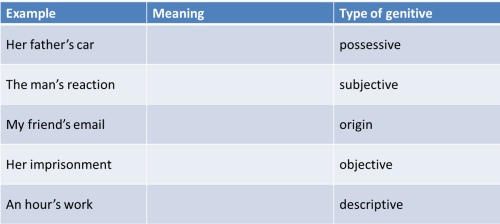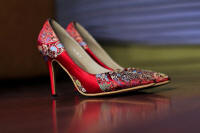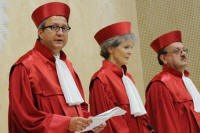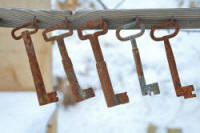The genitive in English

 |
What is the genitive case? |
The genitive is a case which is usually understood to refer to ownership of something. As we shall see, however, a better definition encompasses rather more and it is a case expressing at least:
- possession
- source
- origin
- description
Usually in English, case is unmarked so, if you have followed the guide to case on this site, you will know that although these sentences express case:
- The man kissed the woman
- The woman kissed the man
In English, we only know who did what to whom by the order of the words.
The subject comes first in both sentences so we know that is the doer of
the action. The object follows the verb so we know that is the
receiver of the action. If we reverse the order, we reverse the
sense.
In many languages, the nouns (man and woman) or the article (the)
would be identifiable as referring either to the subject or the
object of the verb. They would be described as nominative (the
subject) and accusative (the object).
Many will assert that English does not, for this reason, have a
case-structured grammar and, apart from the use of the pronoun
system, that is generally true.
The exception in English is that the genitive case is marked and it is marked in four ways:
- By the inclusion of an 's' preceded or followed by an
apostrophe as in, e.g.:
The woman's property - By a periphrastic expression with the preposition of
as in:
The property of Mrs Smith - By a possessive determiner as in:
Her property - By a possessive pronoun as in:
The property is hers
Modern English does not inflect any other item to show the genitive
case so the object noun is unmarked (the word property and the
article the remain unchanged throughout).
Other languages will mark the noun and the article and may often inflect
other items such as any adjectives in the same way to show the genitive
(and often other cases).
The guide to case identifies at least nine other common cases in a range
of languages and there are more that it does not consider.
 |
The genitive in English |
| with his feet on her case |
The genitive in English is often called the possessive case but
the situation is a bit more complicated as was stated at the outset than just
indicating possession.
An example is
The reaction of the man to the woman's kiss was unexpected.
This tells us whose reaction and whose kiss we are talking about.
It also exemplifies the inadequacy of talking about possessives in
English because it is not likely that we see a reaction or a
kiss as
something one possesses.
We have here two forms of the genitive:
- the inflected form: inserting the 's or s' at the end of the noun (the woman's kiss)
- the periphrastic form: using the preposition of to show
the relationship (the reaction of the man). In fact, other prepositions, such as
from and by are possible. For example:
The man from the government called
The examination by the doctor
but of is the one of choice.
Here are five examples of the use of the genitive in English. Can you fill in the middle column with what relationship between the nouns the case is indicating? Click on the table when you have an answer.

(Source: Quirk et al, 1972:193)
So the genitive in English has four other uses in addition to showing possession. Other languages will work differently so you need to use the analysis to make sure you are presenting and analysing things accurately and not allowing your learners to believe that the form in English is just to do with ownership.
Even the possessive use can be subdivided and some languages will
use a different form to distinguish between, for example:
John's car
and
John's weight
because in the first case the possession is not absolutely fixed and
in the second it is. The distinction may be described as
alienable vs. inalienable, respectively. There is a
little more on this below because the way that possession is
expressed in English is also affected by the concept of
alienability.
 |
The five meanings |
At the outset, we identified four possible types of genitive in English and now we have added a fifth, the objective use of the genitive. Here they are, explained with examples:
 |
1. The possessive genitive |
If we can paraphrase a statement using the verb have, we
are normally talking about a possessive use of the genitive.
Even here, however, the concept of possession is not appropriate in
all cases.
It is clear that in:
That's the child's toy
The possessive is natural because we can rephrase the clause
with
The child has / owns that toy
We cannot, however, easily rephrase:
The vicar's brother
as
The vicar owns a brother
although
The vicar has a brother
is a natural rephrasing.
Equally
Jupiter's orbit
is not the equivalent of
Jupiter has an orbit
There is one more important distinction to be made here and it is a distinction that many languages rely on quite heavily: alienable and inalienable possession. Briefly:
- Alienable possession refers to objects that can change
ownership such as computers, cars, houses, books etc.
In this sense, we can use verbs like own and
possess as in, e.g.:
John owns a large house
She possesses three laptops
etc.
We can also use the verb have in this sense:
John has a large house
She has three laptops - Inalienable possession refers to entities which cannot
change hands sensibly so we have, for example:
John has a bad leg
She has beautiful hair
Mary has three brothers
etc.
In this sense, of course, verbs such as own cannot be used so we do not allow:
*John owns a bad leg
*She owns beautiful hair
*Mary possesses three brothers
Some languages, as we noted, make more of this distinction and will not allow verbs to cross the divide.
 |
2. The subjective genitive |
The subjective genitive refers to the nature of the subject of a
clause. For example:
John's disappearance
can be rephrased as
John disappeared
and
Mary's disagreement
can be
Mary disagreed
It is clear in this case that we are not talking about
possession in any sense but about the subject of the imagined verb.
There is no useful way that we can attribute ownership to either the
disagreement or the disappearance in examples like this so calling
this a possessive at all is misleading.
 |
3. The genitive or origin |
Here we are considering the source of the noun. For
example:
The court's decision
can be paraphrased as
The decision the court produced
and
His uncle's telephone call
clearly is a call that originated from his uncle.
Again, possession per se plays no role.
 |
4. The objective genitive |
The second of these uses of the genitive, above, referred to the subject but this type
of genitive refers to the object of the clause that we can make by
paraphrasing the expression. For example:
The arches are the bridge's support
can be paraphrased as
The arches support the bridge
and
Susan's arrest
as
Someone arrested Susan
No sense of possession is present.
We will note here and below that some ambiguity can arise concerning
whether a genitive refers to the subject (type 2., above) or the
object (this category). For example, in:
The doctor's examination
most will assume the subjective use and be able to paraphrase
this as
The doctor examined
However, in:
The man's investigation
it is unclear without context and co-text whether the correct
paraphrase is:
Someone investigated the man (an objective use)
or
The man investigated something or someone (a
subjective use)
 |
5. The descriptive genitive |
In this case, paraphrasing usually means a use of some kind of
adjectival, classifying or post-modifying expression. For
example:
A Master's degree
refers to the type of degree and could be rephrased using a
classifier as
A post-graduate degree
and
The teachers' room
as
The room set aside for teachers
No sense, except very marginally, of possession is involved
although the second example could be paraphrased as
The teachers have a room
but not as
The teachers own a room.
 |
The flexibility of the genitive in English |
The following draws on Huddleston et al (2002:474) to
demonstrate the large range of meanings that the genitive in English
can signal. It is important to do so because other languages,
most in fact, do not share the structures and prefer to express the
relationships encoded by the genitive in English in other ways.
The examples here all use the genitive 's construction but
that need not be the preferred choice for all the examples.
The left-hand columns contain example expressions and the right-hand
columns are
used to illustrate, not define, the meanings encoded by the genitive structure.
| Example | Signalling | Example | Signalling | |
| John's black hair | a physical attribute | her father's first book | human creation | |
| Peter's elder brother | a blood relationship | her father's obituary | topic | |
| Jean's husband | a non-blood relationship | her father's illness | suffering / undergoing | |
| the woman's boss / deputy | a hierarchical relationship | the room's furnishings | containing | |
| the boy's friends | a social relationship | last year's fashion | the time of | |
| Mary's team | membership | the element's radiation | natural creation | |
| the company's rehearsal | performance | the building's windows | constituent part | |
| Fred's house | ownership | the computer's monitor | associated part | |
| John's embarrassment | emotional state | the argument's origins | cause | |
| her father's letter | origin | the war's consequences | result |
As you see, they are extremely variable and not confined to the
five categories we have already identified although many may be
considered subsets of those.
It is perilous to assume either that the meanings will be encoded in
similar ways in other languages or that the meanings will be easily
grasped by learners of English. Some will, some won't.
 |
The four marked forms |
We identified above the four forms which signal a genitive and they were:
- Possessive determiners
- Possessive pronouns
- The genitive 's' (often called the Saxon genitive)
- The of genitive (a periphrastic formulation)
Forms 1. and 2. can be handled together because they refer to the same kind of issue.
The genitive determiner and pronoun system is defective in English as this table shows:
| Person, gender and number | possessive determiner | pronoun |
| First person
singular (all genders) |
my | mine |
| First person
plural (all genders) |
our | ours |
| Second person
(all genders, all numbers) |
your | yours |
| Third person singular masculine | his | |
| Third person singular feminine | her | hers |
| Third person singular neuter | its | - |
|
Third person plural (all genders) |
their | theirs |
The system is defective in comparison to many other languages because:
- Only the third person singular has any gender marking and even that is defective because the same word (his) serves as both a determiner and a pronoun.
- The second person shows no distinction for number, familiarity or gender with only one determiner (your) and one pronoun (yours).
- There is no pronoun for the third person singular neuter at
all. We cannot say, in English:
Where did that screw come from?
*It is its.
Many other languages are a lot more sophisticated (and
complicated).
For example, French shows a distinction in determiners (ma
or moi) depending on the gender of the noun but has the
same form (à moi) for the pronoun. French, too,
distinguishes between forms of the second-person pronoun depending
on familiarity (the tu-vous distinction) and German does
much the same also having a plural form of the familiar which French
lacks (euer).
Other languages may have separate forms for various genders, levels
of familiarity and numbers and some are very complex indeed with
lots of case, gender and number inflexions or separate forms.
Comparatively, English is very simple but the distinction between
the pronoun and determiner forms can create difficulties as does the
lack of certain pronouns and determiners.
 |
The two main genitive constructions |
|
the contents of the flask the flask's contents |
The lack of complexity in the pronoun and determiner system is a bonus for learners but it is made up for by the difficulty associated with a peculiarity almost unique to English, namely, two ways to show the genitive on nouns: the Saxon genitive 's' and the of-structure.
 |
Which form to use? |
English is quite unusual in having two genitive forms to call on and most languages make do with just the one. Deciding which to use is not at all easy.
 |
Task: Which of the following are normally not acceptable? Jot down the letters (a to x) of the ones you wouldn't accept. Click here when you have a list. |
|
|
|
|
It is possible, of course that we will disagree. However, most people would suggest that the following are, if not wholly unacceptable, then at least slightly odd or stilted:
| a. the car's cost c. the pencil of Mary h. the ears of the dog p. the work of a day |
r. the ambition of my life t. the chair's legs v. the toys of the children w. the house's roof |
 |
Why should this be? |
Traditionally, the explanation is that we use the periphrastic
structure with of for inanimate objects and the 's or
s' structure with animate ones but that is not at all the end
of the story.
If the rule were so simple, then London's parks
and gardens, a day's work and the country's future would
all be wrong.
 |
Task: Can you figure out a better set of rules? What do you tell your learners? Click here when you have something noted down. |
- Lower animals and inanimate objects

With so-called 'lower' animals and wholly physical inanimate objects, we prefer the of-structure. If we always select this one for such nouns, we will very rarely be wrong. We can sometimes say:
the bacterium's nucleus
but we will never be wrong if we prefer
the nucleus of the bacterium.
Many people will accept, for example:
the street's position
the car's battery
the room's decor
the book's topic
the building's design
and thousands of other inanimate objects with the 's genitive in use.
However, it is less likely that the same people would accept:
?the chair's leg
?the window's frame
?the screen's brightness
?the house's design
and many more.
Quirk et al (1972:201) simply conclude, slightly despairingly:
one of them is, however, generally preferred for reasons of euphony, rhythm, emphasis, or implied relationship between the nouns
but that is not a useful rule to give to a learner of English, of course.
Because the area is so variable and unpredictable the best advice for learners is to stick to the of-formulation unless and until you have heard a native speaker use the 's formulation.
See also below in the short section on avoiding the genitive by using noun adjuncts. - People

With personal names, nouns for people, nouns for collections of people and higher animals we prefer the inflected form. It is possible to have:
the government of the country
but if we prefer
the country's government
we won't be wrong. If we prefer
*the pencil of Mary
however, we will be wrong.
(A small quirk here concerns the use of whose. Questions with whose, although they refer to the genitive case, cannot be answered with the of-formulation. For example,
Whose policy is it?
can elicit:
The government's
but cannot be answered with
of the government.) - Times

With nouns for time spans we prefer the inflected, 's or s' form:
a week's money
two years' hard labour
today's headlines
an hour's wait
etc.
In all these cases, most would find the of-construction strange and many would reject something like:
?*the work of an hour
outright. - Places

There's a range of intermediate cases where both forms are equally acceptable. Nouns in this category include geographical entities.
Germany's population / the population of Germany
nouns relating to places
the restaurant's garden / the garden of the restaurant
and some nouns referring to human activity
the influence of philosophy / philosophy's influence
the novel's plot / the plot of the novel
However, the of-structure is always acceptable with these sorts of nouns. - Apposition

There is, however, no choice of structure when a noun phrase is set in apposition to another, both referring to the same entity (i.e., they are co-referential).
We may, for example, allow both:
Jane Austin's novels are greatly loved
and
The novels of Jane Austin are greatly loved
but when apposition is used we can only allow the periphrastic form as in:
The novels of Jane Austin, the Victorian writer, are greatly loved
and we do not allow:
*Jane Austin's, the Victorian writer, novels are greatly loved.
We can, however, circumvent the rule in very informal language with:
?*Jane Austin, the Victorian writer's novels are greatly loved
but that is better avoided and many would not find it acceptable at all. - Markedness

When both forms are acceptable, as is often the case, one may be more marked than the other so there is, in fact, a difference between:
The building's fourth floor
and
The fourth floor of the building
The inflected structure emphasises the building as being the point of reference and the periphrastic form emphasises the floor.
This also occurs with purely possessive meanings so:
My neighbour's house
emphasises the owner and
The house of my neighbour
emphasises the house. - Ambiguity

One function of the genitive is described in the table above as objective insofar as it refers to the object of a verb. One example given there was:
the woman's imprisonment
in which the woman is the object of the imprisoning and both the 's form and the of-formulation are acceptable so we can equally have:
the imprisonment of the woman.
However, there are times when it is necessary to use the of-formulation or another prepositional phrase to avoid ambiguity.
For example:
the man's investigation
could mean:
the investigation into the man
or
the investigation done by the man
If the former is intended then
the investigation of the man
is preferred (the man was investigated, not the man did the investigation).
Compare, too:
the doctor's examination
with
the examination of the doctor
in the first of which the doctor is the subject who did the examination and in the second of which, the doctor is the object of examination.
The rule of thumb is to reserve the of-formulation for objective genitives and keep with the 's formulation for humans in subjective genitive expressions whenever there is a need to avoid ambiguity.
(You should also note a few fixed-phrase oddities: a stone's throw, at my wits' end, your money's worth, in arm's reach, at arm's length etc.)
 |
The double genitive |
Double genitives, with a marker attached to more than one entity
are reasonably common and uncontroversial. We can
encounter, therefore:
John's parents' car is parked outside
and so on.
This can even apply to three entities as in:
John's parents' car's battery is flat
but that is the limit cognitively with which most people can happily
deal.
However, a double genitive applied to only one entity is
something on which generally speaking grammarians will frown.
It is averred, therefore that:
This is a friend of Peter's
That is a book of my brother's
or
Piglet is a friend of Winnie the Pooh's
are malformed and should be rephrased as
This is Peter's friend
That is a book of my brother
Piglet is is a friend of Winnie the Pooh
and in any other way that allows only one genitive marker.
They are, nevertheless, quite commonly heard and go by unremarked,
despite the obviously flawed nature of the second redundant genitive
marker.
In fact, the double genitive marker is not only common and
unremarkable, it is obligatory with certain structures.
There is, for example, no way in which:
She's the only friend of theirs who came to the wedding
where the genitive marking occurs once with the of-formulation
and once more with the use of the possessive pronoun theirs,
can be sensibly rephrased to avoid the issue.
It cannot, for example be replaced with:
*She's the only friend of them that came to
the wedding
or with:
*She's the only their friend who came to the
wedding
This use of an obligatory double genitive is confined to human
referents for the marker but it is unavoidable and unavoidably
redundant.
We may be right to caution against the use of the double genitive
with non-human referents as in:
That is book of the library's
because that is easily rephrased without the double marking but for
human references, no such prohibition can be sustained.
Had the English language a powerful cultural overseer such as the
Academie Francaise, the issue would doubtless have been resolved in
favour of its avoidance.
You may see the double genitive described in other terms as the
pleonastic genitive, oblique genitive or post-genitive.
Whatever it is called, it remains a grammarians' itch.
 |
Avoiding the genitive: noun adjuncts |
| The bull fight or corrida de toros |
In many languages, it is exceptional or impossible to use a noun
to modify another and that's why the Spanish translation of bull
fight uses the genitive preposition de to make
corrida de toros. Not so in English.
We saw above that although many genitive constructions are
permissible using the 's / s' formulation with inanimate
objects, many are clumsy and produce unacceptable phrasing, so while
most will accept
the book's cover
the picture's frame
the door's colour
and so on, other uses of the genitive inflexion are much more
questionable and they may include:
?the desk's leg
?the window's pane
?the computer's keyboard
and so on. In these cases, there is a choice to be made
and one option, as we saw, involves using the of-formulation
and constructing:
the leg of the desk
the pane of the window
keyboard of the computer
etc. However, these sorts of expressions are also
perceived by many as somewhat clumsy.
The other option is more elegant and simply involves using the noun
to classify or categorise the other so we can make:
the desk leg
the window pane
the computer keyboard
and so on.
This use of nouns as classifiers is referred to as making them noun
adjuncts and you may find them referred to as attributive nouns,
qualifying nouns, noun (pre)modifiers or apposite nouns. This
is an elegant solution which needs to be taught because many
languages simply cannot do it. That may partly explain why
mistranslations abound in signs directing English speakers to
The Port of Calais or The Airport of Kalamata.
Thus it is that we see, for example:
Luton Airport
rather than the clumsier The Airport of Luton or
Luton's Airport
There is more on the use of noun adjuncts in the guide to partitives
and classifiers, linked below.
 |
Phrase modification: the phrasal possessive |
| The man in the park's dog |
English is, again, unusual in allowing the genitive 's'
structure to be appended to a whole noun phrase after the
post-modification. We allow, at least in speech, therefore:
The woman in black's husband
The girl in room six's note
The people from Austria's complaint
and so on.
This is not immediately intuitive for most learners.
The same constraints concerning the types of nouns which are allowed
with this construction apply so many would not accept:
?The table in the corner's leg
To avoid the informality of such expressions, the alternative
genitive construction is preferred in writing and formal speech:
The husband of the woman in black
The note from the girl in room six
The complaint by the people from Austria
but this breaks the rule above concerning the naturalness of using
the 's' genitive with people.
The issue is one of phrase constituents and, because we perceive the
whole of the modified noun phrase as the subject or object of the
verb, we avoid, for example:
*The woman's in black husband
because it is nonsense so we prefer:
The woman in black's husband
and also
The man's dog in the park
because that ascribes the modification to the wrong noun and
implies that the man is not in the park so we would also prefer:
The man in the park's dog
It can also lead to
absurdity as in:
The woman's eyes in the corner
 |
Warning: when of is not a genitive signal |
The prepositional phrase of + noun is not, of course,
always a marker of the genitive. In the following examples, no
genitive is intended and no replacement with 's, however
unnatural sounding, can be accepted.
the City of London
the news of the birth
the love of money
a man of integrity
memories of childhood
etc.
What is happening here is that the noun is being post-modified by a
prepositional phrase describing an attribute and no genitive sense
can be assumed.
For more examples of how a prepositional phrase can be used to
post-modify nouns and noun phrases, see the guide to noun
post-modification, linked below. In that guide, the genitive
of-structure is considered as just one of a range of eight
post-modifying prepositional phrases.
Another frequent occurrence of of + noun phrase is in
partitive expressions and assemblage terms. For example:
a rasher of bacon
a pane of glass
a flock of sheep
a shoal of fish
and in none of these cases is there any sense of a genitive case
structure.
 |
Pronunciation of 's and s' and of |
If learners have already mastered the pronunciation of the third-person s and the plural s, then this will not be problematic because the same rules apply:
- Following /s/, /z/, /ʃ/, /ʒ/, /tʃ/ or /dʒ/, the
pronunciation is /ɪz/. E.g.:
the class' teacher (/ðə.ˈklɑː.sɪz.ˈtiː.tʃə/)
the disease's symptoms (ðə.ˌdɪ.ˈziː.zɪz.ˈsɪmp.təmz/)
the fish's habitat (/ðə.ˈfɪ.ʃɪz.ˈhæ.bɪ.tæt/)
the luge's rules (/luːʒɪz.ruːlz/)
the church's position (/ðə.ˈtʃɜː.tʃɪz.pə.ˈzɪʃ.n̩/)
the judge's decision (/ðə.ˈdʒə.dʒɪz.dɪ.ˈsɪʒ.n̩/)
- When following any other voiceless consonant, /p/, /t/, /k/,
/f/ or /θ/, the pronunciation is /s/.
the ship's captain (/ðə.ˈʃɪps.ˈkæp.tɪn/)
the government's decision (/ðə.ˈɡə.vərmənts.dɪ.ˈsɪʒ.n̩/)
the pack's leader (/ðə.pæks.ˈliː.də/)
the staff's attitude (/ðə.ˈstæfs.ˈæ.tɪ.tjuːd/)
a month's work /ə.ˈmənθs.ˈwɜːk/)
- Otherwise, the pronunciation is /z/. E.g.:
David's car (/ˈdeɪ.vɪdz.kɑː/)
Japan's population (/dʒə.ˈpænz.ˌpɒ.pjʊ.ˈleɪʃ.n̩/)
the computer's memory (/ðə.kəm.ˈpjuː.tərz.ˈme.mə.ri/)
John's house (/ˈdʒɑːnz.ˈhaʊs/)
the paper's editor (/ðə.ˈpeɪ.pəz.ˈed.ɪt.ə/
etc.
The preposition of is almost always weakened to /əv/ and
may even in very rapid speech, especially between two vowels, be simply /v/ so we get, e.g.:
the opinion of the majority
(/ði.ə.ˈpɪ.nɪən.əv.ðə.mə.ˈdʒɒ.rɪ.ti)
the navy of Australia (/ðə.ˈneɪ.vi.vɒ.ˈstreɪ.liə/)
| Related guides | |
| pronouns | for a guide to the pronoun system of English (which is case marked) |
| case | for a guide to a wider area |
| classifiers and partitives | for more on noun adjuncts |
| noun post-modification | which considers the genitive of-structure in the context of other noun post-modifying structures |
References:
Chalker, S, 1987, Current English Grammar, London: Macmillan
Campbell, GL, 1995, Concise Compendium of the World's Languages,
London: Routledge
Huddleston, R and Pullum, GK et al, 2002, The Cambridge
Grammar of the English Language, , Cambridge: Cambridge University Press
Quirk, R, Greenbaum, S, Leech, G & Svartvik, J, 1972, A Grammar of
Contemporary English,
Harlow: Longman
